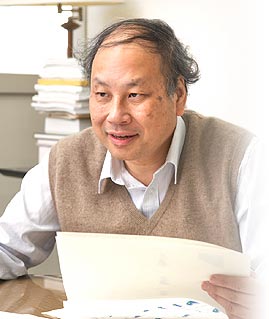
|
Program Overview > Program Members > Masafumi, Takiguchi
|

Center for AIDS Research, Professor
Immunology, M.D., D.Med.Sci. Deputy Program director, Program Board member, Research on cellular immunology for HIV-1

 |
 I initiated my efforts to investigate T cell immunology for HIV-1 in 1993 and have been in this scientific area over 15 years. Especially I focused on the role of HIV-specific cytotoxic T cells (CTLs) in HIV infection. In addition, I recently started the study of HIV-1-specific CD4 T cells. |
|
1. The role of cellular immunity in HIV-1 infection 1) Mechanism of HIV-1-specific CTLs to recognize HIV-1 I established a system to identify epitopes that HIV-1-specifc cytoroxic T cells (CTL) recognize, which were called as reverse immunogenetics (AIDS 10:1075-1083, 1996.),though this strategy had been established with Dr. A. Hill, Oxford University for identification of Malaria epitopes (Nature 360:434-439, 1992.). By using this strategy, I had identified more than 50 HIV CTL epitopes presented by HLA class I alleles commonly found in Asian countries (J. Immunol. 158:5026-5034, 1997, J. Immunol. 159:6242-6252, 1997. etc.). I developed this system to join with a strategy using overlapping peptides and newly identified many epitopes. These epitopes have being utilized by many scientists in the field of HIV-1 Immunology. I investigated the ability of HIV-1-specific CTLs to suppress HIV-1 replication because it may be associated with the control of HIV-1 in vivo. I established the in vitro assay to detect the ability of HIV-1-specific CTLs to suppress HIV-1 replication (ref 1) and found that this ability of the CTLs is epitope-dependent (ref 2). I also found that 2 Pol-specific CTLs with strong ability to suppress HIV-1 replication are highly detected in long-term non-progressors and slow progressors carrying HLA-B*5101 and that the frequency of one of these CTLs is reversely correlated with viral load, indicating that this CTL has the ability to suppress HIV-1 replication in vivo. These CTLs also have strong ability to suppress HIV-1 replication in both T-tropic virus-infected CD4+ T cells and M-tropic virus-infected macrophages (ref 3). The result suggested that these T cells can effectively eradicate HIV-1 in infected macrophages. We are now looking for other CTLs that contribute to suppression of HIV replication in vivo.
2) Escape of HIV-1 from HIV-1-specific CTLs
3) Mechanism of HIV-1-specific CD4 T cells to recognize HIV-1
|
|

|
♦Reference |
|
| 1. | Hiroko Tomiyama, Hirofumi Akari, Akio Adachi and Masafumi Takiguchi: Different effects of Nef-mediated HLA class I down-regulation on HIV-1-specific CD8+ T cell cytolytic activity and cytokine production. J. Virol. 76:7535-7543, 2002. |
| 2. | Hiroko Tomiyama, Mamoru Fujiwara, Shinichi Oka, and Masafumi Takiguchi: Cutting Edge: Epitope-dependent effect of Nef-mediated HLA class I down-regulation on ability of HIV-1-specific CTLs to suppress HIV-1 replication. J. Immunol. 174: 36-40, 2005. |
| 3. | Mamoru Fujiwara and Masafumi Takiguchi, HIV-1-Specific CTLs Effectively Suppress Replication of HIV-1 in HIV-1-infected Macrophages, Blood 109:4832-4838, 2007 |
| 4. | Yuka Kawashima, Katja Pfafferott, John Frater, Philippa Matthews, Rebecca Payne, Marylyn Addo, Hiroyuki Gatanaga, Mamoru Fujiwara, Atsuko Hachiya, Hirokazu Koizumi, Nozomi Kuse, Shinichi Oka, Anna Duda, Andrew Prendergast, Hayley Crawford, Alasdair Leslie, Zabrina Brumme, Chanson Brumme, Todd Allen, Christian Brander, Richard Kaslow, James Tang, Eric Hunter, Susan Allen, Joseph Mulenga, Songee Branch, Tim Roach, Mina John, Simon Mallal, Anthony Ogwu, Roger Shapiro, Julia G. Prado, Sarah Fidler, Jonathan Weber, Oliver G. Pybus, Paul Klenerman, Thumbi Ndung'u, Rodney Phillips, David Heckerman, P. Richard Harrigan, Bruce D. Walker, Masafumi Takiguchi*, and Philip Goulder* (*equally contribution) Adaptation of HIV-1 to Human Leukocyte Antigen class I . Nature 458: 641-645, 2009 |
| 5. | Mamoru Fujiwara, Junko Tanuma, Hirokazu Koizumi, Yuka Kawashima, Kazutaka Honda, Saori Mastuoka-Aizawa, Sachi Dohki, Shinichi Oka and Masafumi Takiguchi, Different Ability of Escape Mutant-Specific Cytotoxic T Cells to Suppress Replication of Escape Mutant and Wild-type HIV-1 in New Hosts, J. Virol. 82: 138-147, 2008 |
| 6. | Nan Zheng, Mamoru Fujiwara, Takamasa Ueno, Shinichi Oka, and Masafumi Takiguchi, Strong ability of Nef-specific CD4+ cytotoxic T cells to suppress HIV-1 replication in HIV-1-infected CD4+ T cells and macrophages, J. Virol. In press |
 |
 |